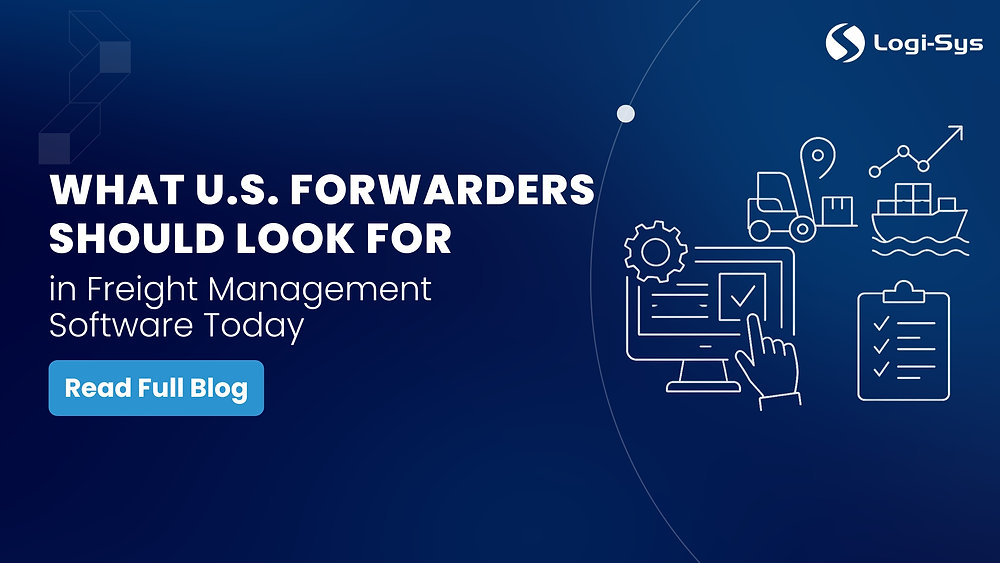
As shipment volumes return to steady highs and service expectations grow sharper, U.S. freight forwarders are encountering a quieter—but deeply consequential—challenge: operational disconnect.
Most freight businesses today run a combination of tools—some off-the-shelf, others legacy, many improvised. One for job creation. Another for finance. A third for tracking. Over time, these tools build silos where data needs bridges, and processes rely on memory instead of systems.
This fragmentation doesn’t always show up in big failures. It shows up in the small inefficiencies that add up: a margin miscalculated, a receivable delayed, a task missed, a customer kept waiting for answers. Individually survivable. Collectively limiting.
Which is why many forwarders today are no longer asking, “Do we have the tools?” They’re asking, “Do the tools work together?”
What to Expect from a Modern Freight Management System
The modern freight management system isn’t a digital filing cabinet or a tracker. It’s the operating layer that quietly connects all the moving parts—across shipments, teams, branches, and partners.
Forwarders evaluating freight forwarding software today are looking for more than checkboxes. They’re seeking integration that’s meaningful, visibility that’s real-time, and automation that doesn’t need babysitting.
Some of the capabilities that matter most:
-
Multi-modal shipment handling—air, sea, and land, across exports and imports
-
Auto-generated documentation—from AWBs to Bills of Lading and manifests
-
Live milestone tracking—visible to internal teams, customers, and agents
-
Integrated job costing and invoicing—triggered by operational events, not manual prompts
-
Built-in financial controls—profit-per-job, receivables, inter-branch billing, credit tracking
-
Sales CRM alignment—from lead capture to quote to job creation
-
Portals and mobile access—not just for convenience, but for accountability
These are not bonus features. They’re the foundation of freight management software that’s built to handle volume, variation, and velocity—without needing more headcount.
Where Many Freight Systems Still Fall Short
Despite wide availability of freight solutions in the U.S., a number of forwarders still operate on partial systems. A TMS with no finance module. A CRM that doesn’t talk to operations. Spreadsheets stitched into dashboards. And accounting tools that are disconnected from cost data.
The gaps aren’t just technical, they’re operational:
-
A delay in operations means a delay in invoicing
-
Missed updates slow down collections
-
Revenue gets booked, but margins stay invisible
-
Sales can’t track conversions beyond the quote
-
Finance chases data across teams, not screens
These issues don’t stem from a lack of software. They stem from the absence of a unified platform—one that’s freight-specific, multi-functional, and built to evolve with the business.
For U.S. forwarders who’ve outgrown makeshift solutions, Logi-Sys offers a modern freight ERP platform designed not just to handle freight—but to harmonize it.
It’s not a toolset. It’s a freight-specific, cloud-native infrastructure that aligns all operational, financial, and commercial functions—so forwarders can move faster, make smarter decisions, and scale without chaos.
Key Pillars That Set Logi-Sys Apart:
1. Operational Depth, Not Surface Automation
From air and ocean exports to road movements and complex consolidation models—Logi-Sys handles every shipment type. Jobs are linked to quotes, documentation auto-generates, and every update flows into the system live, feeding real-time visibility across teams.
2. Job-Linked Financial Accounting
Built-in financials mean zero reliance on external systems. Multi-currency invoicing, credit control, audit-ready books, and branch-wise profitability—Logi-Sys brings it all together with role-based access, locks, and reporting built for freight.
3. Multi-Branch & Global Coordination
Run inter-branch billing, track receivables by office, and unify reporting across regions. Logi-Sys supports centralized control with local execution—ideal for forwarders with domestic spread or cross-border operations.
4. CRM That Talks to Operations
Leads convert to jobs without re-entry. Quotes are versioned, tracked, and visible to sales and finance. Managers get conversion insights; sales teams get full pipeline visibility. Customer engagement is no longer disconnected from delivery.
5. Task-Level Discipline and Workflow Control
Define internal SLAs with task-based workflows. Assign ownership. Trigger alerts. Use live status tracking and customizable milestones to reduce manual follow-ups. Execution becomes predictable, repeatable, and less dependent on individual memory.
6. Mobile, Portals, and Real-Time Access
Operations don’t stop when you leave the desk. With Logi-Sys, managers approve tasks, track jobs, and respond to alerts via mobile. Customers get branded portals for tracking, documents, and billing—all in sync with your system. Vendors and agents plug into the same jobs without chasing emails.
7. A Unified Platform, Not a Patchwork of Apps
Logi-Sys runs on a single database. Every transaction—financial or operational—is interlinked. No syncing. No duplicate entries. No blind spots. The result? Consistency, accuracy, and the confidence that what you’re seeing is exactly what’s happening.
This is what modern freight management software should feel like: connected, context-rich, and made for how real forwarding businesses operate.
Final Word: Structure Your Growth. Don’t Just Scale It.
Scaling freight operations in the U.S. doesn’t have to mean adding more tools, more teams, or more troubleshooting.
With Logi-Sys, you get a freight management system that matches your business—not just in functionality, but in mindset: one platform, total visibility, real control.
